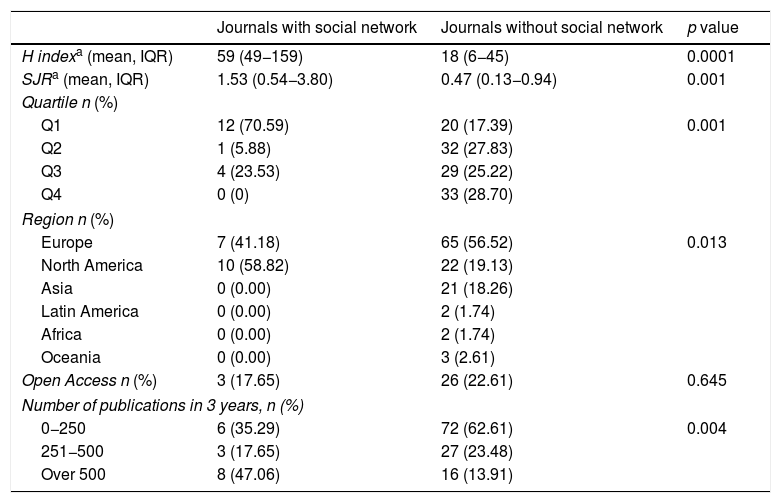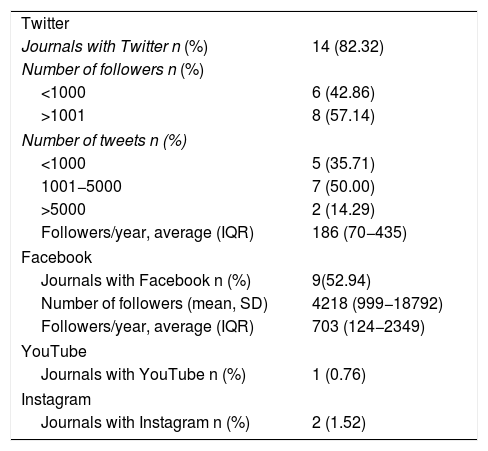Social networks are a means for disseminating scientific information. Alternative metrics assessing the impact of scientific publications on social networks have been created. Our study aims to assess the correlation between the activity of internal medicine journals on social networks and traditional metrics based on citations.
MethodsInternal medicine journals were identified in the SCImago-Scopus database and information on traditional impact metrics was extracted. In addition, alternative metrics of activity were determined for Facebook, Twitter, YouTube, and Instagram. The correlation was assessed through Spearman's correlation coefficient.
ResultsOf 134 Internal Medicine journals, 17 had a presence on the social networks evaluated. The SJR index was higher in journals with a presence on social networks vs. those without (59 vs. 18, p < .0001). The overall correlation between the SJR index and the number of followers/year was very strong for Facebook (Spearman's correlation coefficient 0.95, p < .05) and strong for Twitter (Spearman's correlation coefficient 0.54 p < .05).
ConclusionsOur study suggests that there is a very strong correlation between social network activity metrics (mainly Facebook and Twitter) compared to traditional metrics based on the number of citations of internal medicine journals.
Las redes sociales son medios de divulgación de información científica. Se han generado métricas alternativas que evalúan el impacto de publicaciones científicas en redes sociales. Este estudio busca evaluar si existe correlación entre la actividad de las revistas de medicina interna en las redes sociales y las métricas tradicionales basadas en citaciones.
MétodosSe identificaron las revistas de medicina interna a partir de la base de datos SCImago. Se extrajo información de las métricas tradicionales y alternativas de actividad de las revistas en Facebook, Twitter, YouTube e Instagram. Se evaluó correlación mediante el coeficiente de Spearman.
ResultadosDe un total de 134 revistas de medicina interna, 17 contaban con presencia en las redes sociales evaluadas. El índice SJR fue más alto en revistas con red social vs. sin red social (59 vs. 18, p < 0,0001), y la correlación global entre el índice SJR y el número de seguidores/año en Facebook fue muy fuerte (coeficiente de Spearman 0,95, p < 0,05) y fuerte para el número de seguidores/año en Twitter (coeficiente de Spearman 0,54, p < 0,05).
ConclusionesNuestro estudio sugiere que existe una correlación muy fuerte entre las métricas de actividad de las redes sociales, comparado con las métricas tradicionales basadas en el número de citaciones en revistas de medicina interna.
Article
Diríjase desde aquí a la web de la >>>FESEMI<<< e inicie sesión mediante el formulario que se encuentra en la barra superior, pulsando sobre el candado.

Una vez autentificado, en la misma web de FESEMI, en el menú superior, elija la opción deseada.

>>>FESEMI<<<









